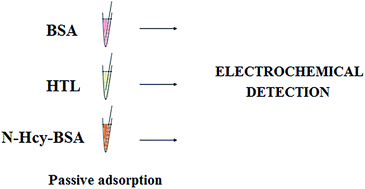Homocysteine-thiolactone (HTL) is known as an intramolecular thioester of homocysteine (Hcy). The thioester chemistry of Hcy-thiolactone underlies its ability to form isopeptide bonds with the protein lysine residues, which may impair, or alter the function of protein. HTL modification is a unique post-translational protein modification that is recognized as an emergent biomarker for cardiovascular and neurovascular disease. Electrochemical detection of bovine serum albumin (BSA) before and after N-homocysteinylation was performed using a disposable graphite electrode in combination with a differential pulse voltammetry (DPV) technique. Accordingly, an enhanced detection of BSA was obtained based on the changes at the oxidation signal of BSA after N-homocysteinylation. A lower detection limit was obtained for N-homocysteinylated BSA (N-Hcy-BSA) as 1.09 μg mL−1 in comparison to the one of non-homocysteinylated BSA (i.e., 1.55 μg mL−1). The DL of BSA and N-Hcy-BSA in fetal bovine serum medium was also calculated and found to be 3.29 μg mL−1 and 2.72 μg mL−1, respectively.

